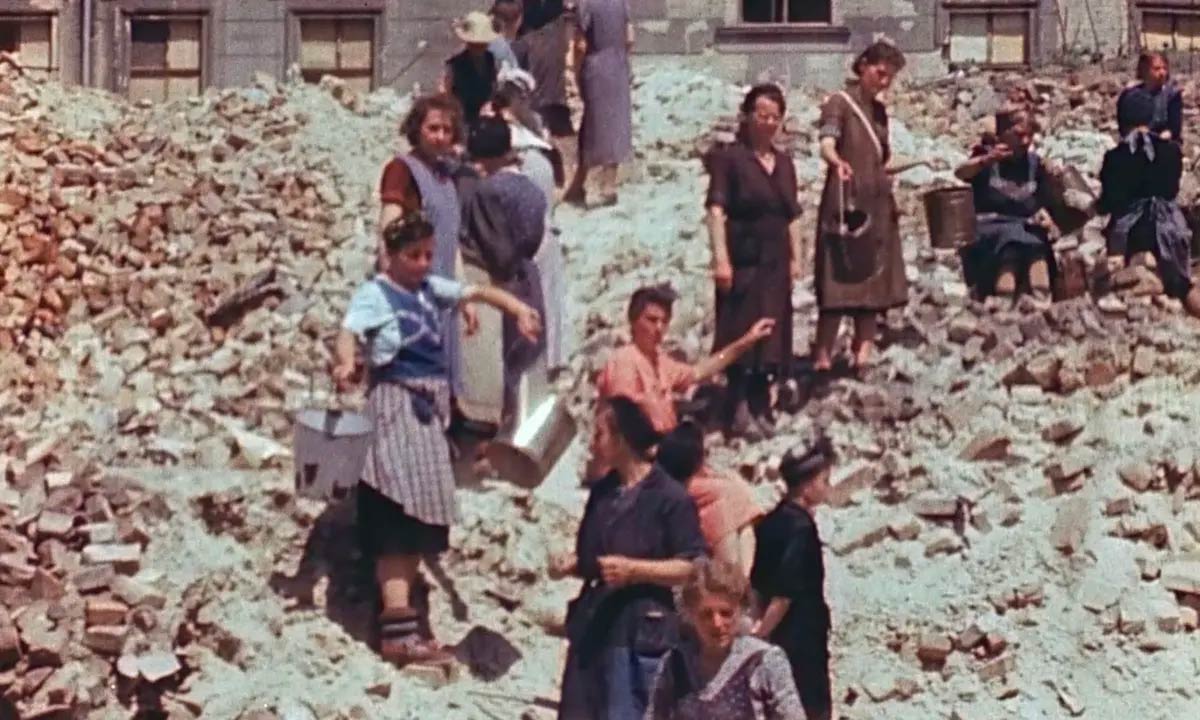A documentary with no guardrails, “The Natural History of Destruction” (“NHD”) lurches through its 105-minute runtime with no concern for its audience’s bearings or balance. Commendable in its own way, eschewing as it does the omnipresent talking head and clip art formula so pervasive on the documentary scene, it is also devoid of context and narrative challenges.
READ MORE: Cannes Film Festival 2022 Preview: 25 Must-See Films To Watch
Director Sergei Loznitsa deploys archival period footage to exclusive effect, withholding voiceover, expert interviews, on-screen text, or anything that might identify the where/when of what is presented aside from architecture and wardrobe clues. Sharp-eyed viewers familiar with Weimar-era fashion and urban settings might be able to peg the early scenes as pre-war Germany, but for most, the Swastika banners that pop up at around the 10-minute mark are the first real clue of what Loznitsa is showing.
Idyllic scenes of both rustic and vogue Europe transition into bird’s eye views of saturation bombing of those same cities, and the ghastly devastation wrought by that ordinance. The point the documentary is making with this approach is not a subtle one, yet it is indeed effective. Loznitsa takes extra pains to show the faces of the people working in the fire brigades, or on the munition factory floors, connecting the broader theory of war to the human element. In this way, “NHD” challenges the audience’s understanding of how this or any conflict was/is prosecuted by making broad history intimate.
War is always terrible, in any form, and while World War II didn’t invent the idea of attacking urban centers as a tactic, the popular mythology surrounding the Allied cause has certainly excused the methodology. “NHD” uses its naked archive footage to put the onus back on the viewer to reexamine their understanding of what it means to fight a “just” war, and the barbarism that can be excused under such circumstances. And while it is indeed an interesting thought experiment that seems devoid of influence or suggestion by way of its presentation, the conversation is more complex than this.
Anyone looking at footage of bodies being pulled from the rubble would be quick to condemn any tactics that endanger non-combatants as barbarous, yet that precludes the consideration of several equally appalling circumstances. Allied soldiers fighting against tank and infantry brigades supplied and supported by those same cities would have likely argued such action was justified, as would any prisoners in (or on their way to) camps like Auschwitz or Treblinka.
“NHD” doesn’t grapple with any of this, deciding instead to drive home the human element behind both sides of the Allied bombing campaign of Germany. At one point, munitions factory workers, encouraged by Field Marshall Bernard Montgomery himself, are shown getting a pep talk to keep the bombs and planes churning on the assembly line. These are the same bombs that pummel the women, children, and elderly in Germany’s urban heartland, where Joseph Goebbels urges the citizenry to continue resisting.
Again, it is a very interesting and timely topic, and one obviously close to the heart of the Ukranian-born Loznitsa, yet there’s just no perspective, here. This idea that targeting civilians is okay, but only when facing an obstinate foe whose evil can no longer be sanctioned, is fascinating, yet is this even the broad historical consensus? If it is, what constitutes the “red line” on evil, and who makes that decision?
Structurally, “NHD” has issues as well. Scene transitions throw the audience from Germany to England without any warning, and viewers who aren’t able to identify wartime aircraft by a fuselage Roundel might be confused at times. Likewise, historical figures appear without any introduction, robbing younger generations of some much-needed context when figures like Winston Churchill appear.
The documentary is also ponderously slow, often holding onto shots for far longer than is necessary to make a point already clear. There is a score that pops in at times, notably in the closing minutes, but most of the sound is foley work meant to recreate the atmosphere of the footage presented, the quality and effectiveness of which varies. And while the intentions of the documentary seem commendable, this topic is just too complex, too dense with historical precedence to unfold as it does here.
Moving and evocative, to be sure, yet far too thin on perspective and some much-needed context, “The Natural History of Destruction” is just a bit too lean for its own good. Brave in a Spartan sort of way, Loznitsa’s documentary effectively asks a question, yet never approaches anything close to an answer or even a conversation that would have served the broader topic in a satisfying way. [C-]
Follow along with all our coverage from the 2022 Cannes Film Festival.





